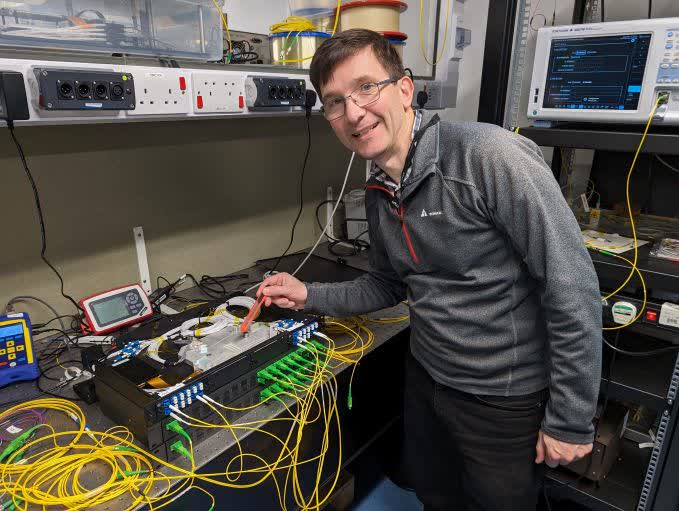## Revolutionizing Data Speeds with Fiber Optics
**The Digital Era Demands Speed:** Have you ever stopped to think about how crucial the rapid movement of data has become in our connected world? It’s not just about streaming your favorite shows without the dreaded buffer icon popping up. This month, a team of bright minds has pushed the boundaries even further, setting the stage for a future where our data doesn’t just walk; it sprints.
Researchers at Aston University in the UK have been busy making headlines in the digital world. They’ve managed to blast data across standard fiber optics at mind-bending speeds of 301,000,000 megabits per second. To put that into perspective, it’s like comparing a Formula 1 car to a bicycle in terms of speed. This leap forward wasn’t just a small step; it was a giant leap that smashed past the speeds reported by Ofcom in their 2023 broadband performance report.
**Unlocking the Speed of Light:** At the heart of this breakthrough is something you might’ve heard of but never thought much about: fiber optics. These are the thin strands of plastic or glass that crisscross beneath our cities and oceans, carrying blips of light that represent the data we send and receive every day. Traditionally, data is transmitted using specific light wavelengths. However, the team led by Professor Wladek Forysiak and Dr. Ian Phillips had a eureka moment. They tapped into previously unused wavelengths, adding new lanes to our data superhighways.

**Expanding the Spectrum:** In the world of fiber optic communications, there’s a bit of a traffic jam. The most traveled roads are the C-band and L-band wavelengths. But when there’s too much congestion, data can’t travel as quickly as we’d like. That’s where Forysiak and Phillips’ work comes into play. They’ve turned to the E-band and S-band, regions of the spectrum that were like unused express lanes, waiting to be opened. Through some clever engineering involving new optical amplifiers and gain equalizers, they’ve successfully integrated these lanes into our global data highway.

**A Future Without Limits:** This isn’t just a triumph of speed. It’s a glimpse into a future where internet providers can supercharge our connectivity without digging up roads to lay down new cables. Imagine downloading the entire Library of Congress in the blink of an eye, or streaming 4K movies with zero delay. That’s the potential world we’re stepping into.
**Beyond Today’s Speeds:** While Aston University’s achievement is jaw-dropping, it’s worth mentioning that it’s not the fastest speed ever recorded. That title goes to researchers in Japan who hit the 1.02 petabits per second mark using a customized cable. Yet, what makes Aston’s achievement so remarkable is that it was done using the infrastructure that’s already in place beneath our feet.
In essence, we’re standing on the cusp of a new era in digital connectivity. As we look to the horizon, we can’t help but wonder: what incredible innovations will come next in the quest to keep our world connected at the speed of light?




